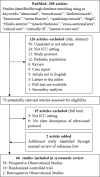Methodologies and clinical applications of lower limb muscle ultrasound in critically ill patients: a systematic review and meta-analysis
- PMID: 39443352
- PMCID: PMC11499498
- DOI: 10.1186/s13613-024-01395-y
Methodologies and clinical applications of lower limb muscle ultrasound in critically ill patients: a systematic review and meta-analysis
Abstract
Background: Reduced muscle mass upon admission and development of muscle wasting are frequent in critically ill patients, and linked to unfavorable outcomes. Muscle ultrasound is a promising instrument for evaluating muscle mass. We summarized the findings of lower limb muscle ultrasound values and investigated how the muscle ultrasound parameters of the examination or the patient characteristics influence the results.
Methods: Systematic review and meta-analysis of studies of lower limb ultrasound critically ill adults. PubMed, CINAHL, Embase, PEDro and Web of Science were searched. PRISMA guidelines were followed, and studies evaluated with the appropriate NIH quality assessment tool. A meta-analysis was conducted to compare the values at admission, short and long follow-up during ICU stay, and the association between baseline values and patient characteristics or ultrasound parameters was investigated with a meta-regression.
Results: Sixty-six studies (3839 patients) were included. The main muscles investigated were rectus femoris cross-sectional area (RF-CSA, n = 33/66), quadriceps muscle layer thickness (n = 32/66), and rectus femoris thickness (n = 19/66). Significant differences were found in the anatomical landmark and ultrasound settings. At ICU admission, RF-CSA ranged from 1.1 [0.73-1.47] to 6.36 [5.45-7.27] cm2 (pooled average 2.83 [2.29-3.37] cm2) with high heterogeneity among studies (I2 = 98.43%). Higher age, higher BMI, more distal landmark and the use of probe compression were associated with lower baseline muscle mass.
Conclusions: Measurements of muscle mass using ultrasound varied with reference to patient characteristics, patient position, anatomical landmarks used for measurement, and the level of compression applied by the probe; this constrains the external validity of the results and highlights the need for standardization.
Study registration: PROSPERO CRD42023420376.
Keywords: Critically ill; Lean body mass; Meta-analysis; Muscle ultrasound; Muscle wasting; Systematic review; Ultrasound.
© 2024. The Author(s).
Conflict of interest statement
MU has received speaker fees from Baxter, Fresenius Kabi and Nestlè. The other authors declare that they have no conflicts of interest.
Figures





Similar articles
-
Phase angle and rectus femoris cross-sectional area as predictors of severe malnutrition and their relationship with complications in outpatients with post-critical SARS-CoV2 disease.Front Nutr. 2023 Nov 21;10:1218266. doi: 10.3389/fnut.2023.1218266. eCollection 2023. Front Nutr. 2023. PMID: 38075215 Free PMC article.
-
[Clinical value of early bedside ultrasound measurement of quadriceps femoris in diagnosis of ICU-acquired weakness].Zhonghua Yi Xue Za Zhi. 2020 Jul 7;100(25):1967-1972. doi: 10.3760/cma.j.cn112137-20191129-02609. Zhonghua Yi Xue Za Zhi. 2020. PMID: 32629598 Chinese.
-
Association between ultrasound quadriceps muscle status with premorbid functional status and 60-day mortality in mechanically ventilated critically ill patient: A single-center prospective observational study.Clin Nutr. 2021 Mar;40(3):1338-1347. doi: 10.1016/j.clnu.2020.08.022. Epub 2020 Aug 28. Clin Nutr. 2021. PMID: 32919818
-
Evaluation of Appendicular Muscle Mass in Sarcopenia in Older Adults Using Ultrasonography: A Systematic Review and Meta-Analysis.Gerontology. 2022;68(10):1174-1198. doi: 10.1159/000525758. Epub 2022 Jul 25. Gerontology. 2022. PMID: 35878591 Free PMC article.
-
The Diagnostic Value of Ultrasound of the Rectus Femoris for the diagnosis of Sarcopenia in adults: A systematic review.Injury. 2022 Nov;53 Suppl 3:S23-S29. doi: 10.1016/j.injury.2022.06.004. Epub 2022 Jun 15. Injury. 2022. PMID: 35732560
Cited by
-
Lung re-aeration assessment by ultrasound during mechanical ventilation: Current knowledge of literature review.Multidiscip Respir Med. 2025 Jun 3;20(1):1029. doi: 10.5826/mrm.2025.1029. Multidiscip Respir Med. 2025. PMID: 40458897 Free PMC article.
-
Combined Effects of Early Mobilization and Nutrition on ICU-Acquired Weakness.Nutrients. 2025 Mar 19;17(6):1073. doi: 10.3390/nu17061073. Nutrients. 2025. PMID: 40292494 Free PMC article. Review.
References
-
- Batt J, Dos Santos CC, Cameron JI, Herridge MS. Intensive care unit–acquired weakness: clinical phenotypes and molecular mechanisms. Am J Respir Crit Care Med. 2013;187(3):238–46. - PubMed

